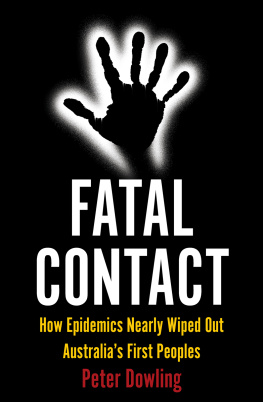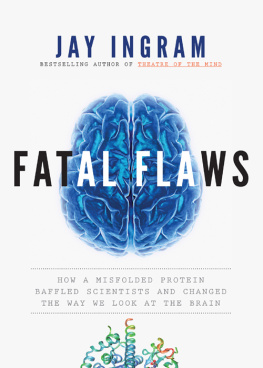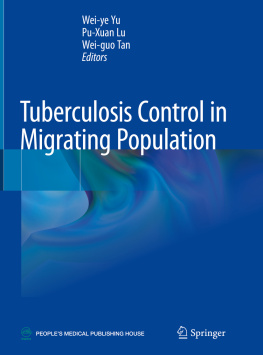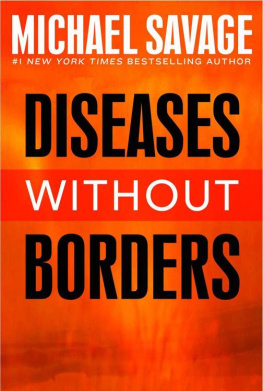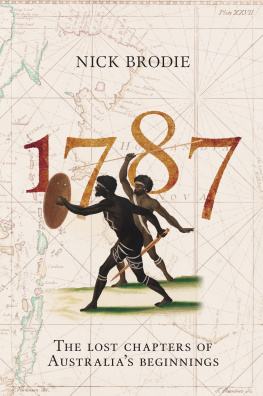Contents
Page List
Guide

CULTURAL WARNING
Aboriginal and Torres Strait Islander people should be aware that this book contains the names of deceased persons.
ABOUT THIS BOOK
Fatal Contact explores the devastating infectious diseases introduced into the Indigenous populations of Australia after the arrival of the British colonists in 1788. Epidemics of smallpox, tuberculosis, influenza, measles and sexually transmitted diseases swept through the Indigenous populations of the continent well into the twentieth century. The consequences still echo today in Aboriginal health and life expectancy.
Many historians have acknowledged that introduced diseases caused much sickness and mortality among the Aboriginal populations and were part of the huge population decline following colonisation. But few writers have elaborated further, and much of this history is still missing, even after more than 200 years. Our knowledge and understanding of the biological consequences surrounding the meeting and contact of these two cultures has not yet been fully investigated.
Fatal Contact examines the major epidemics and explains the complexities of disease infection and immunology: which diseases were responsible for the Aboriginal population decline across Australia in the colonial period, when and where did they occur, how severe were they, how long did they last, which diseases were more devastating, and why were they so devastating? The book also considers the individual medical history of Truganini, the Tasmanian Aboriginal woman erroneously known as the last Tasmanian. By focusing on the disease burden she faced during her life, the author creates a deeper and personal understanding of how First Nations Australians suffered and yet survived.
What this investigation reveals is nothing short of the greatest human tragedy in the long history of Australia. This is a vitally important story that all Australians should read.
Fatal Contact: How Epidemics Nearly Wiped Out Australias First Peoples
Copyright 2021 Peter Dowling
All rights reserved. Apart from any uses permitted by Australias Copyright Act 1968, no part of this book may be reproduced by any process without prior written permission from the copyright owners. Inquiries should be directed to the publisher.
Monash University Publishing
Matheson Library Annexe
40 Exhibition Walk
Monash University
Clayton, Victoria 3800, Australia
publishing.monash.edu/
Monash University Publishing brings to the world publications which advance the best traditions of humane and enlightened thought.
Monash University Publishing titles pass through a rigorous process of independent peer review.
ISBN: 9781922464460 (paperback)
ISBN: 9781922464477 (pdf)
ISBN: 9781922464484 (epub)
Edited by Kerry Davies AE
Internal design by Les Thomas
Cover design by Les Thomas
Typeset by Jo Mullins
A catalogue record for this book is available from the National Library of Australia.
CONTENTS
LIST OF TABLES
For those First Nation People who suffered from the epidemics. Most of them nameless to history and in many cases unknown to history. Left out and missing from the human story of Australia.
ACKNOWLEDGEMENTS
Putting this tome on the shelves of bookshops has been a long process lasting over two decades. I have not done this alone. During its course I have had the help, advice and comment of many people along the way and to them I owe a deep and lasting gratitude. It is with their unquestioned help, willingness and support that this book has been produced.
First and foremost is my wife, Dianne, who at all stages supported, carried and guided me through this whole process from beginning to end.
I am especially grateful to Dr Robert Attenborough, my primary PhD supervisor at the Australian National University, who, with a red pen in hand, reviewed each chapter of my thesis making it a much better document and which now has formed the basis of this book.
Professor Isabel McBryde, my second PhD supervisor, guided me to the historic collections in the state libraries and archives and showed me how to interpret them and then persuaded me to put everything together and publish as a book. It has taken some time but that is down to me.
Professor Judith Littleton was a fellow post-graduate student in biological anthropology at ANU, a supporter and constructive critic of my work, who has become a long-term friend.
The late Professor Colin Groves was my MA supervisor at ANU who was the first to comment and guide me in writing on this subject.
My former colleagues and friends from the ANU: Dr Goran Sevo, who has also graciously read sections of the draft manuscript for this book and commented where I strayed on medical interpretations; Dr Jan Klaver, Dr Kate Stockhausen, Dr Helen Cooke and Dr Keiko Tamura, who at various stages assisted me in field research and listened to me in the early days of my research into this project.
During my time at ANU I had the great honour and privilege to mentor and tutor students studying archaeology and biological anthropology through the Tjabal Indigenous Higher Education Centre. They came from different parts of Australia and their ages varied from the younger to the senior. But they were all eager to learn. While I may have influenced them in some way, I know that I learned a lot from the experience. I thank them for assisting and influencing me.
I also thank Dr Elizabeth Williams who thoughtfully discussed this project, providing help over coffees at the National Library of Australia, and Dr Fenja Theden-Ringl for kindly reading and commenting on the introduction.
A special thanks to Georgia Harrison-Dowling, my much-valued research assistant, particularly in the latter stages of this book, for giving her time during her third year at Monash University to help her grandfather continue research in the midst of a developing COVID-19 pandemic and subsequent lockdown.
My family in Melbourne, Michael, Deborah, Georgia, Charlie, Jamie, and Mia for showing interest, encouragement and support in this project and for giving me the opportunities to tune out a bit and get back to the realities of family life.
I also gratefully thank my extended family in South Australia, Tasmania, and the Australian Capital Territory for willingly helping me in field and archival research and for their unconditional support over the years I have been engaged in this project. Also David and Jessie in Dubai for their encouragement.
To Derrick (Noddy) and Leann Brassington for many years of friendship, dinners and coffee.
During the research and writing of this book the National Library of Australia gave me a quiet place in the Petherick Reading Room among the books and manuscripts, many of which have been used in this story. My appreciation goes to the staff for their endless, professional help. A special thanks must go to one, Sarah Schindeler at the NLA, who first encouraged and invited me to join the Petherick Readers group. And so, a grateful thanks must also go to my fellow Petherick readers for the coffee breaks and lively discussions we all enjoyed while plodding on with our various research topics.
The Canberra and District Historical Society and the National Trust ACT gave me access to their libraries and collections. I spent many quiet and industrious hours in their offices all the while trying not to get distracted by the wealth of historic material they held.

